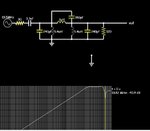CataM
Advanced Member level 4
- Joined
- Dec 23, 2015
- Messages
- 1,275
- Helped
- 314
- Reputation
- 628
- Reaction score
- 312
- Trophy points
- 83
- Location
- Madrid, Spain
- Activity points
- 8,409
In the mentioned thread there is no 13.56 MHz whatsoever.For the selective filtering, as you already see in thread #48, the data link itself can reject some of the noise in the frequency at 13.56MHz. I guess this is not enough. If we look at this post answered by you (https://www.edaboard.com/threads/364923/#post1562652), I can see the noise coupling at the Rx data coil with both 6.78MHz power link and 13.56MHz power link.
----
You guess it is not enough @36 dB of attenuation ? You do not have to guess, you have to calculate and see if it is good enough for you. (or measure as you did not measure even though you claimed to).For the selective filtering, as you already see in thread #48, the data link itself can reject some of the noise in the frequency at 13.56MHz. I guess this is not enough.
As a rough estimation, you can assume the current through the power coil is fairly sinusoidal and hence you have a linear circuit in which Superposition theorem can be applied, which means, you can estimate the influence on the data coil by the power coil at ~13.56 MHz with 36 dB attenuation. Estimate how much does that influence your data coil and if it distorts the 1 to 5 MHz data coil signal.
- - - Updated - - -
In the datasheet, there seems to be 2 different coils called wpc (wireless power coil ?) and nfc (non ferrite coil ? ). Do you actually have one of those? Which one ?My power coils (both Tx and Rx) are 760308103307 from Wurth.
